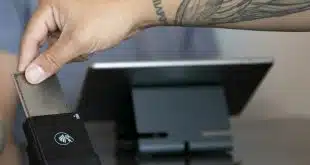To Justin Bigham, head of consumer product management at regional bank holding company First Niagara Financial Group Inc., the answer to the question of whether chip credit cards based on the EMV standard should have PINs isn’t hard to figure out. Just ask consumers.
The 390-branch firm plans to convert its entire 250,000-card credit portfolio as well as its 900,000-card debit portfolio to chip-and-PIN by early 2016.
That the bank’s EMV debit cards will have PINs is no surprise, because that’s what most debit issuers are doing. But PINs on chip-based credit cards will put Buffalo, N.Y.-based First Niagara in a distinct minority.
Most banks and credit unions are going with so-called chip-and-signature authentication for credit cards as the U.S. graduates from magnetic-stripe payment cards to the more secure EMV standard.
First Niagara disclosed its plans just a day before the U.S. EMV liability shift took effect Oct. 1. Under that shift, the merchant or issuer in a card transaction that doesn’t support EMV will bear liability for any resulting counterfeit fraud.
Retailers are pushing hard for chip-and-PIN with credit cards, but issuers are divided. Issuers’ oft-stated rationale is that cardholders are used to entering PINs with debit transactions, but not with credit. Plus, some issuers claim their processors don’t support PIN entry on credit transactions yet, or that the costs for implementing chip-and-PIN don’t outweigh the reduced fraud.
The EMV microprocessor generates a one-time code and effectively thwarts most counterfeit fraud, while the addition of PIN entry can stop lost-and-stolen card fraud—which isn’t as big as counterfeit fraud. The most prominent U.S. chip-and-PIN credit card proponent so far has been Raleigh, N.C.-based State Employees Credit Union, one of the biggest credit unions in the country.
But Bigham says consumers want to use PINs with all of their cards. He cites a MasterCard Inc. survey saying that 62% of consumers polled prefer PINs. “It’s the most secure form,” he says.
First Niagara carefully considered the argument that Americans aren’t used to entering PINs with credit card transactions. It concluded they could adapt, as have consumers in Canada and Europe, where chip-and-PIN authentication is common though not universal. One reason: most credit card holders also have a debit card, so PIN entry is not a foreign concept to them.
“We were very confident [that] the one con, a change in customer experience, we felt we could change-manage that,” says Bigham.
A big part of that “change management” will come from an upcoming consumer awareness and education program by the company, whose branches are in New York, Pennsylvania, Connecticut, and Massachusetts.
First Niagara tested EMV cards with about 50 employees for a month. While Bigham says employees are “somewhat biased” about payments, most transactions went quickly and smoothly, and there were enough merchant locations already live with EMV terminals that the bank concluded it could go ahead and roll out chip-and-PIN to its customer base.
“The reception, the experience they had was very, very positive,” he says.
Bigham himself made purchases at a Starbucks in Denver, at a Buffalo pizza place and Home Depot store, and at multiple stores in nearby Canada.
All of First Niagara’s credit and debit cards are MasterCards.
—Jim Daly




